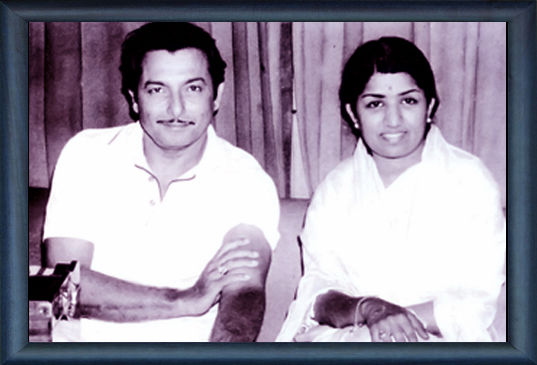Lata Mangeshkar, one of the most popularly known names ever in the world, was on September 28, 1929 in Indore, Madhya Pradesh. She was born in a family of music. Her father, Pt. Dinanath Mangeshkar, owned a theatrical company and was a reputed classical singer. He qas a disciple of the Gwalior school of music. Dinanathji gave Lata singing lessons from around the age of five along with her other sisters Asha, Usha and Meena. Lata also studied with Aman Ali Khan Sahib and later Amanat Khan.
Lata Mangeshkar has always been a unique combination of a God-gifted voice, optimised expression and an unbelievable ability to easily pick up and inherit whatever is taught. Because of these characteristics, Lata's talent was recognised from an early age itself. When her father died in 1942, Lata being the eldest child was responsible for being the bread winner of the family. Between 1942 and 1948 she acted in as many as 8 films in Hindi and Marathi to take care of the family's economic problems. She also made her debut as a playback singer in the Marathi film Kiti Hasaal (1942) but the song was edited out!
Travelling by Bombay's local trains, the scrawny but determined struggler who would always be accompanied by a sister, finally won her first break as a playback singer with Aap Ki Sewa Mein (1947). With established singers like
Amirbai Karnataki,
Shamshad Begam and
Rajkumari around, Lata's thin voice strained to be heard. However, leading composer
Ghulam Haider reposed his faith in Lata and gave her songs in Majboor and Padmini (Bedard tere pyar ko), that brought her some attention.
But the true efflorescence of Lata's talent was witnessed in 1949 when she unleashed a fusillade of superhit songs in three musical blockbusters:
Naushad's Andaaz,
Shanker-Jaikishan,'s Barsaat and
Khemchand Prakash's Mahal. By 1950 the Lata wave had changed the Industry. Her high-pitched singing rendered obsolete the heavy basy nasal voices of the day. Only Geeta Dutt and to a certain extent
Shamshad Begam survived the Lata onslaught.
Asha Bhosle too came up in the late 1940s and the two sisters were the queens of Indian playback singing right through to the 90s.
Lata's initial style of singing was reminiscent of Noor Jahan but she soon got over that to evolve her own distinguished style. With her search for perfection she corrected her Urdu by hiring a tutor! Her phenomenal success made Lata the most powerful woman in the Film Industry. She waged battle with
Mohd. Rafi in the 1960s and stopped singing with him over the issue of royalty to playback artistes. She refused to sing for
S.D. Burman from 1957 - 62 and such was her clout that she had her way and they came back to her. Though Lata sang under the baton of all the top composers barring
O.P. Nayyar and with all the top playback artistes of the day, special mention must be made of her work for
C. Ramchandra who made her sound her sweetest and
Madan Mohan who challenged her voice like no other music director. The 1960s and 70s saw Lata go from strength to strength even as there were accusations of her monopolizing the field.
When Film Fare announced its Best Playback Singer Award, it was but natural that the first recipient be Lata who won it for Madhumati's dulcet siren song, 'Aaja Re Pardesi..' in 1958. Besides her hits, Lata also won critical acclaim for her rendition of maestro
Pandit Ravi Shanker's tunes in Hrishikesh Mukherjee's Anuradha. Then Prime Minister Pandit Jawaharlal Nehru was famously moved by Lata's rendition of the non-film patriotic number 'Aye Mere Watan Ke Logon..' and she was awarded the Padma Bhushan in 1969.
In the 70's and early 80's, Lata's position at the top was unshakeable as the three leading music directors of the period,
Laxmikant Pyarelal,
R. D. Burman and
Kalyanji Anandji, lavished their best on her. Whether it was Satyam Shivam Sundaram, Sholay or Muqaddar Ka Sikander, Lata was a common factor. Lata's Royal Albert Hall concert in London paved the way for other shows. In the disco era of the mid 1980s, Lata drastically cut down on her workload though she did have the occasional hit like Ram Teri Ganga Maili. The Lata-dominated scores of Chandni and Maine Pyaar Kiya coincided with resurgence of romance at the close of the decade. Since then, Lata has attached herself to, and worked largely, with quality banners like RK (Henna), Rajshris (Hum Aapke Hain Koun...!) and Yash Chopra (Dilwale Dulhania Le Jayenge, Dil Toh Pagal Hai). With new music directors like A R Rahman, Lata proved herself equal to still creating something exquisite like Zubeidaa's 'So Gaye Hain..'
Today, Lata has busied herself with The Master Dinanath Hospital. The diva is fond of watching cricket and is an avid photographer. Lata, who is still single, continues to be devoted to her art. Even today, she removes her chappals before entering the recording room.

